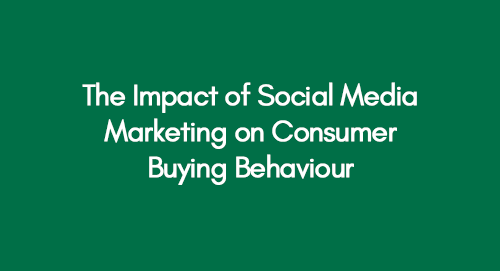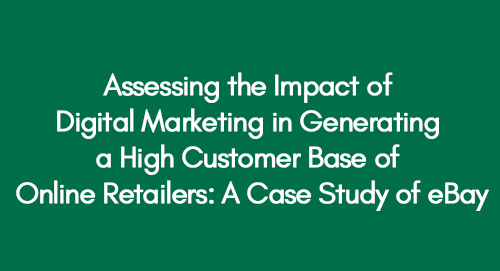
The Role of Local Capacity Development in Mitigating the Challenges Faced In Offshore Drilling
June 1, 2022
The Impact of Social Media Marketing on Consumer Buying Behaviour – A Case Study of M&S, UK
June 1, 2022Introduction
The following literature explores the process of luxury branding and marketing while utilizing a very prominent tool referred to as Brand Luxury Index (BLI). While the discussion is associated with the evaluation of customers' perceptions regarding luxury brands, this study targets "mothers" as the central focus of chosen customer population that are willing to purchase clothes for their kids’ from luxury brands.
Brand Luxury and BLI
At present, the thinking of the majority of people is to opt for luxury brands when they are looking to purchase an item. The perception is that anything purchased from a luxury brand will not only be of high quality but also reflect the status of the individual. Kapferer (2017) states that the term “brand luxury” is described as the consumer thinking that only those products are considered to be branded, which are expensive, are of superior quality, are pleasing to the eyes, and are unique. In simple words, a product purchase from a luxury brand shows that the buyer not only has good taste but can also purchase expensive products. For a consumer looking to understand different degrees of luxury brands, the framework of BLI can be implemented. Vigneron and Johnson created Brand Luxury Index (BLI) scale to measure brands' diverse degrees of luxury (Christodoulides, Michaelidou, and Li, 2009). The BLI scale was created to understand the difference between high-and low-luxury brands. The brand luxury index has five dimensions: perceived conspicuousness, perceived uniqueness, perceived quality, perceived hedonism, and perceived extended self (Christodoulides, Michaelidou and Li, 2009). The dimension of personality-oriented communication is associated with pleasure-seeking and apparent extended-self aspects, while non-personally-oriented communication is linked with conspicuousness, uniqueness, and quality (Conejo, Cunningham and Young, 2020).
Kim (2019) believes that based on the two dimensions, the consumers assess which brand is the high-luxury brand and which is the low-luxury brand in the market. According to Ko, Costello and Taylor (2019), the dimension of perceived conspicuousness derives value for the consumer. While the consumer feels enhanced value and prestige by consuming branded products and services. The dimension of uniqueness adds further value to the self-image of the consumer, consumers tend to feel unique when attributed to such products (Ko, Costello and Taylor, 2019). Further added by Kim and Johnsons (2015), the selling point of branded products is their quality, a brand is recognised due to significant factors, and one big factor is the quality it offers to the consumers. The dimension of hedonism caters to the pleasure factor and identifies the buying behaviour of customers due to the derived pleasure (Kim and Johnsons, 2015). Further according to Kapferer et al. (2017), the consumption of branded products gives pleasure to the consumers as it is different and has more value. Branding has been engraved in the minds of customers, and the social class of an individual is often determined by the brands he/she consumes. Therefore, an individual who consumes more branded items has more value as the individual’s self-image is reflected by his/her affordability of branded products.
BLI and its implication for Brand Marketing
As per Ko, Costello and Taylor (2019), brand marketing is quite different from usual marketing. In brand marketing, since the name of the brand derives more value than the product itself, the emphasis is on selling the product or service under a brand name. In brand marketing, the customer is attracted mainly due to the brand name rather than to the product itself (Ko, Costello and Taylor, 2019). As added by Kim and Johnsons (2015), BLI has implications for brand marketing as the brand is measured as per the value it gives to its consumers. The customers feel enhancement in their prestigious and status when they consume luxury brands thus brand marketing applies to BLI as brand marketing is done to attract customers towards increasing their status and prestige (Kim and Johnsons, 2015). Further added by Kapferer et al. (2017), customers mainly consume a branded product due to the name of the brand as the brand name makes them feel unique and special. Similarly, in brand marketing, the customers are marketed under the brand name in a way thus that they feel unique when they consume the product of the brand. A brand is established after a long journey, and in that journey, it faces many complications where it proves its worth and finally gets recognised.
As stated by Kim and Johnsons (2015), the main component of the brand is its quality, the constant premium quality it gives to its customers is the main reason it received success, thus, while marketing, these brands promise high product quality apart from the value they give. Consumption of luxury brands has become a tool to receive pleasure. Luxury brands are usually of high prices thus consuming them derives pleasure, marketers market their expensive brands to develop a perception that consuming their product will give pleasure to their customers (Kim and Johnsons, 2015). Further added by Kapferer et al. (2017), individuals measure them and other values and worth based on their ability to afford expensive and high-quality products. Marketers brand their products using a similar notion and create value for their products in such ways that after their consumption the consumer feels superior to others (Kapferer et al., 2017). As per Ko, Costello and Taylor (2019), the main focus of brand marketing is to sell the product under the brand umbrella, it is perceived by the people that the product quality is as per the brand’s reputation thus they tend to purchase the product due to this factor. Similarly, marketers tend to use their established brand names to market different products.
Kids’ Luxury Brand and BLI
Kapferer et al, (2017) assert that the BLI (brand luxury index) scale is implemented for all types of luxury brands, irrespective of whether the brand caters to adults' clothing or other products, or kids’ clothing or other products. Conejo and Cunningham, (2016) are of the view that recently a trend has been witnessed in kids’ fashion which is that numerous brands have started to cater specifically to kids’ clothing and their other needs. Numerous brands believe that there has been a significant rise in the birth rate recently, which only means that there would be a need for baby clothes and other baby products. Therefore, focusing on becoming a kids’ brand is the prime approach to take to attain a profit. The BLI scale comes into play in this aspect as well. New mothers are usually more focused on having the best quality products for their kids. Kapferer, (2017) states that many of the new mothers are usually young, which means their thinking is to purchase kids’ products from a brand that is considered to be high-luxury as per the BLI scale. For many of these specific target consumers, low-luxury brands are not an option to even consider purchasing products for their kids (Kapferer, 2017).
According to Kewley (2019), different brands exist in the market that specialised in producing baby clothes. These brands market to young mothers thus whom they purchase their products. As added by Silhouette-Dercourt and De Lassus (2016), the branding of baby clothing can be observed through the brand luxury index. Luxury brands are marketed to increase the status and prestige of the wearer and his/her mother (Silhouette-Dercourt and De Lassus, 2016). Furthermore, as per the study of MacNaughton (2017), the mother herself feels proud of herself when her child wears branded clothes and looks unique. The motherly bond between the mother and her child is also increased when a mother spends resources to purchase premium quality clothes thus that the child will look cute and will be comfortable (MacNaughton, 2017). A mother is filled with happiness and joy when she sees her child in luxury clothes that are not easily affordable thus different brands are designing and producing baby clothes that attract young mothers (Kewley, 2019).
Young Mothers, Brand Luxury, and BLI
According to Silhouette-Dercourt and De Lassus (2016), young mothers want the best product for their children thus they are marketed by different brands to create the perception that their brand is superior to others. As per Setola (2015), a mother is handed the responsibility of her child in most families thus most of the decision regarding the baby’s attire is made by her. Like every other product, branding has taken over baby clothing too, thus mothers want branded baby clothes for their children. Many luxury baby clothing brands exist in the market that is focused on providing appropriate attire for the child to wear (Setola, 2015). Further added by Pinsker (2018), a mother as the decision-maker chooses the most suitable choice for her child, thus the brand luxury index can be applied to the buying behaviour of the mother. As agreed by Amitail, 2016, a woman creates value for herself by wearing fashionable branded clothes, similarly, the attire of her child also contributes to providing value to her, and thus a mother chooses branded clothes for her child to improve her status and prestige in front of others (Amitai, 2016).
A mother adds her value by dressing her child in branded clothes, when her child is wearing luxury attire, the mother has a perception of uniqueness as her child is dressed in expensive attire (Horyn, 2012). As per Silhouette-Dercourt and De Lassus (2016), another, perhaps the biggest, factor that influences the buying behaviour of a mother towards purchasing branded attire for her child is the quality of the product. A mother’s value can be measured by how she presents her infant to others, thus a mother looks for quality clothes for her child that passes the impression of her as a responsible mother. Similarly, a mother derives pleasure when her child is in unique and expensive clothes. When a mother dresses her child in luxury clothes that look good on the child, she is filled with joy and happiness that contributes to giving her pleasure (Silhouette-Dercourt and De Lassus, 2016). Furthermore, as added by Horyn (2012), a mother feels proud of herself when she dresses her child in luxury clothes. Many baby clothing brands in the market are purchased by mothers to increase their self-image in their eyes. A mother sees herself as a responsible mother when she can afford premium quality brands for her child (Horyn, 2012).
Marketing to Young Mothers under BLI
According to Silhouette-Dercourt and De Lassus (2016), mothers are the decision-maker when it comes to buying clothes for their children. Infants are the consumers of different baby products, however, the main customers of the branded baby items are young mothers (Silhouette-Dercourt and De Lassus, 2016). Further added by Pinsker (2018), the marketing campaigns to promote a baby clothing brand are targeted toward young mothers as they are recognized by the marketers to be the main customers. Marketers tend to develop connections between their brand and mothers by using the mother’s love as an emotional tool to create the perception of how their brand can enhance the love and bond between a mother and her child (Pinsker, 2018). Different brands market their clothing product to target young mothers as per the brand luxury index of the mother (Amitai, 2016).
According to Horyn (2012), a mother wants to have status and value thus marketers market their brands to show how a mother can create value for her child and herself when she purchases clothing items. They further make a perception that how their product increases the prestige and status of the child and makes him/her unique (Horyn, 2012). Furthermore, as per MacNaughton (2017), marketers know that a mother feels happy when her child looks cute thus they market their product in a way that shows children wearing cute designed clothes increasing the longing of a mother to see her child in such attires (MacNaughton, 2017). As contributed by Silhouette-Dercourt and De Lassus (2016), a mother feels pleasure when she spends her resources on her child by purchasing luxurious clothes, thus the marketers use a mother’s emotions to show how a mother increases her value by using their branded products. The marketers further use the emotional bond between a mother and her child and use their brand as a means to show how the bond can be strengthened with their brand (Silhouette-Dercourt and De Lassus, 2016). Furthermore, as stated by Christodoulides, Michaelidou, and Li (2009), the quality of the product is the most important factor in making a mother buy a particular brand. The marketers market their brand to create a perception that their brand is better than others, thus mothers, who do not want any discomfort for their children, purchase those clothes that are most comfortable for their children.
Social Media for Luxury Branding- From the perspective of Young Mothers
Most of the branding activities in the current age are done through social media as it possesses the capability of spreading the message of the brands faster than any medium (Silhouette-Dercourt and De Lassus, 2016). According to Vishwanath (2015), the most effective social media website used for brand marketing are Facebook, YouTube, and Instagram. Young mothers are actively present on such social media websites as it helps socialize and communicate with different people (Vishwanath, 2015). Further added by Abidin (2015), another use of social media for young mothers is to share their and their family’s personal life with other people. Young mothers post pictures, videos, and stories of themselves and their children that help them in their identity quest. Different baby clothing brands take advantage of the presence of young mothers on social media to market their products (Abidin, 2015). As added by Silhouette-Dercourt and De Lassus (2016) these baby clothing brands include social media marketing in their marketing campaign as it markets their product to a large number of their customers. Baby clothing brands use social media platforms to actively communicate with their customers and share information regarding their prices and varieties with young mothers.
The brand luxury of millennial mothers
Concerning the findings of Silhouette-Dercourt and De Lassus (2016), a mother of today’s modern era significantly differ from the mothers of the previous generations as they are equally concerned about their lives as they were with the lives of their families. Further added by Vishwanath (2015), millennial mothers are brand conscious and look for branded items for themselves and their babies. These mothers actively use social media platforms to communicate with their friends and colleagues and share their and their children’s stories, pictures, and videos with them (Vishwanath, 2015). According to the contribution made by Abidin (2015), millennial mothers are attracted to brand names when purchasing them or their children as purchasing branded items moves these mothers towards their identity quest. Furthermore, young mothers are also focused on their careers while looking after their kids thus gone are the days of purchasing low-quality and cheap clothes. Young mothers now opt for quality clothes that are often expensive and come in the form of different brands.
Review the Following:
References
Amitai, G., 2016. Inside The Mindset Of The Modern Mom. [online] Target Marketing. Available at: <https://www.targetmarketingmag.com/article/inside-mindset-modern-millennial-mom/all/> [Accessed 25 March 2020].
Christodoulides, G., Michaelidou, N. and Li, C.H., 2009. Measuring perceived brand luxury: An evaluation of the BLI scale. Journal of Brand Management, 16(5-6), pp.395-405.
Conejo, F.J. and Cunningham, L.F., 2016. Current issues in luxury brand research. Journal of International Marketing Strategy, 4(1), pp.66-77.
Conejo, F.J., Cunningham, L.F. and Young, C.E., 2020. Revisiting the Brand Luxury Index: new empirical evidence and future directions. Journal of Brand Management, 27(1), pp.108-122.
Horyn, C., 2012. That Dress Is So Preschool. [online] Nytimes.com. Available at: <https://www.nytimes.com/2012/04/26/fashion/the-rise-of-designer-childrens-lines.html> [Accessed 25 March 2020].
Kapferer, J.N., 2017. Managing luxury brands. In Advances in Luxury Brand Management (pp. 235-249). Palgrave Macmillan, Cham.
Kapferer, J.N., Kernstock, J., Brexendorf, T.O. and Powell, S.M. eds., 2017. Advances in luxury brand management. Springer.
Kewley, C., 2019. 15 Best Brands For Gender-Neutral Baby Clothes That Deliver On Quality, Comfort And Style. [online] The Independent. Available at: <https://www.independent.co.uk/extras/indybest/kids/clothing-footwear/best-gender-neutral-clothing-babies-baby-clothes-place-for-to-buy-kids-a7952641.html> [Accessed 25 March 2020].
Kim, J. and Johnson, K.K., 2015. Brand luxury index: A reconsideration and revision. Journal of Fashion Marketing and Management.
Kim, J.H., 2019. The imperative challenge for luxury brands. International Journal of Retail & Distribution Management.
Ko, E., Costello, J.P. and Taylor, C.R., 2019. What is a luxury brand? A new definition and review of the literature. Journal of Business Research, 99, pp.405-413.
MacNaughton, C., 2017. " I'm a Princess": The Gendered Marketing of Children's Clothing (Doctoral dissertation, Mount Saint Vincent University).
Pinsker, J., 2018. How Marketers Talk About Motherhood Behind Closed Doors. [online] The Atlantic. Available at: <https://www.theatlantic.com/family/archive/2018/10/marketing-conference-moms/572515/> [Accessed 25 March 2020].
Setola, V., 2015. Analysis and research about the consumption of women and young mothers.
Silhouette-Dercourt, V. and De Lassus, C., 2016. Shopping for kids’ luxury brands: young mothers’ identity quest in retail spaces. International Journal of Retail & Distribution Management.
Abidin, C., 2015. Micromicrocelebrity: Branding babies on the internet. M/C Journal, 18(5).
Vishwanath, A., 2015. Habitual Facebook use and its impact on getting deceived on social media. Journal of Computer-Mediated Communication, 20(1), pp.83-98.
Get 3+ Free Dissertation Topics within 24 hours?


















 Download PDF File
Download PDF File







